Tidying Up the KonMari Way: Papers
After dealing with an excess of clutter for years, I wanted to whip my house into shape. So, I decided to tackle the KonMari method of organizing from Marie Kondo’s The Life-Changing Magic of Tidying Up. This post is all about the best way to organize paper files using KonMari’s organization method!
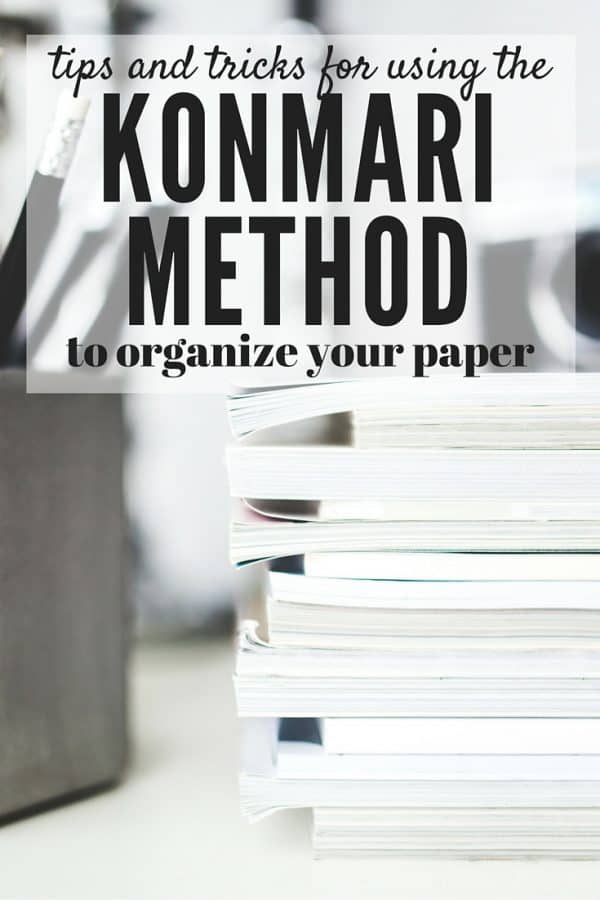
This post contains affiliate links for your convenience. Click here to read my full disclosure policy.
Psst:If you’re decluttering your home and need some help, check out my workshop 30 Days to a Tidy{er} Home. It has daily challenges to help you stay motivated, detailed checklists so you don’t miss a thing, and includes access to a private Instagram page so you can follow along with me as I go through the process! This is a game-changer if you struggle to get your home organized. Click here to learn more – and if you’re interested in a quick sample, CLICK HERE to get it!
I’m a pretty organized person. However, one area I have always struggled to keep organized is paper clutter. Junk mail. Bills. Forms. Paper. It’s the bane of my existence.
I’m the purging type when it comes to clutter, so my natural instinct is “throw away ALL THE THINGS!” Luckily, Marie Kondo tends to agree with me. Seriously…direct quote:
“My basic principle for sorting papers is to throw them all away.”
– Marie Kondo, The Life-Changing Magic of Tidying Up
That’s my girl.
Thank goodness she’s on my side because I am a master of throwing away important papers. (Just ask my husband. I make him crazy with this talent of mine).
Of course, when you’re an adult you can’t just throw away every single paper that comes through your house. It’s just not a good idea and could lead to some trouble down the road.
So, I figured between KonMari and my own obsessive organizing tendencies, I could come up with a system that would work for anyone to organize paper. Here are my steps to help you figure out the best organize paper files and clutter once and for all:
HOW TO ORGANIZE PAPER FILES
Step One: Gather Your Materials:
The first step of this whole thing is to gather all of your papers. Yes, every paper you can find in your whole dang house. Leave the sentimental things out of it for now (that comes later), but grab each and every important and unimportant-looking piece of paper you can find and dump it all in one place.
I chose our dining room table because it’s the only surface large enough to contain all of the chaos.
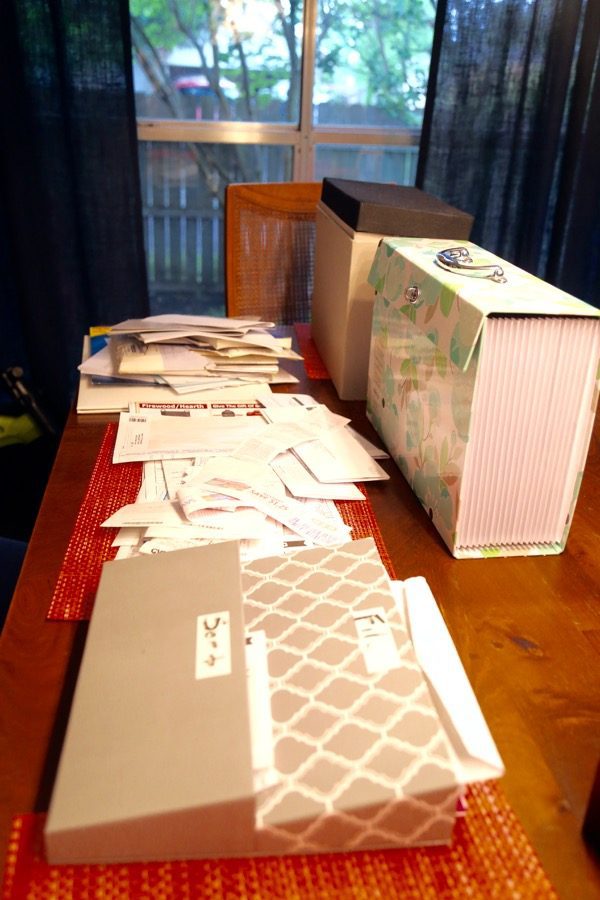
I also grabbed two different paper organizers – Kondo suggests keeping all of your papers in one place, but since I’m starting to have more documents that I need to hold onto for the blog, I figured it would be best to keep blog paperwork and personal paperwork separate. Oh, and I also had my trusty label-maker (seriously, don’t know what I’d do without this thing) and some file folders.
Here’s a quick round-up of the products to kick start getting your paper files organized:
Step Two: Organize Your Paper Into Piles
I used the home file organization categories recommended in the book to organize paper clutter, which are:
– Paper that needs attention (Bills to be paid, forms to be filled out, etc.)
– Paper you need to keep short-term (Tax documents for the current year, warranties, etc.)
– Paper you need to keep forever (Contracts, mortgage paperwork, birth certificates, etc.)
Normally when I try to tackle this project I’m tempted to organize into so many more categories than this – house paperwork, car paperwork, tax paperwork, etc. etc. etc. But doing things this way meant that I was thinking much more critically about what each thing was and what needed to happen with it, which I think will be key to keeping this system in check!
Step Three: Purge!
This will happen naturally to some extent as you organize the papers (anything that doesn’t fit into one of the three categories can be tossed!) but I went through each of the three stacks one more time once I was finished categorizing to make sure that I didn’t miss anything that could be shredded or thrown away.
This is where I had to pull Corey into the process and have him help me out – I’m a big-time purger when it comes to papers, but he was an accounting major in college and is much more careful than me. If he had it his way we would pretty much never throw paperwork away…we settled on a compromise of keeping the last two years’ worth of tax info, and I tried really hard not to argue about other paperwork that he felt was important and I didn’t. In the end, we had quite the stack of trash and shredding, so I’d say we did okay!
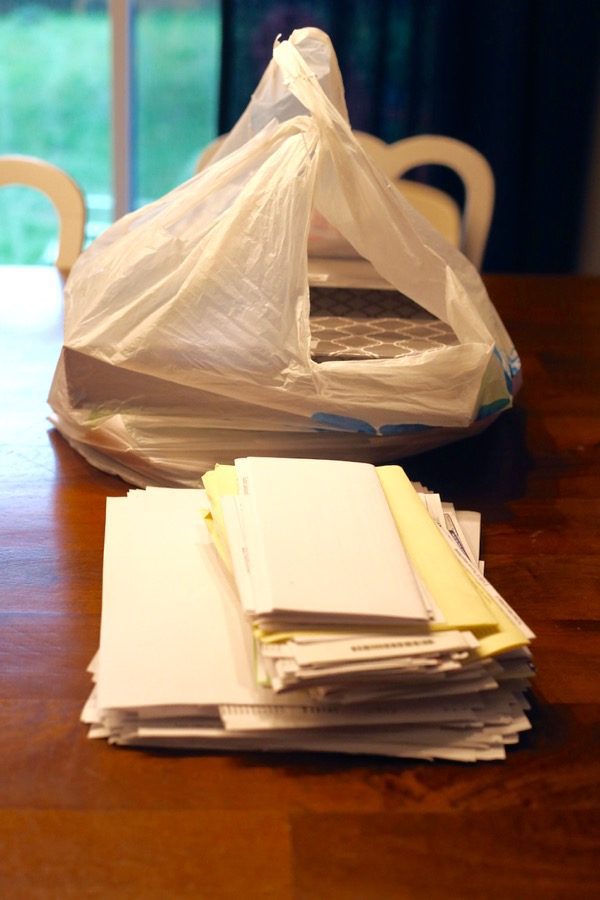
Step Four: Plan, Label, and File Your Papers
Next up was to label my folders in our paper organizer. I stuck pretty much to the categories I sorted my paperwork into, with the added division of tax info for each year so that I can easily purge it when the time comes.
I’m always inclined to label and file into super specific categories (like home, insurance, receipts, etc.), but this exercise helped me to re-think and simplify my categories, and I really think it will be just as easy to find what I need!
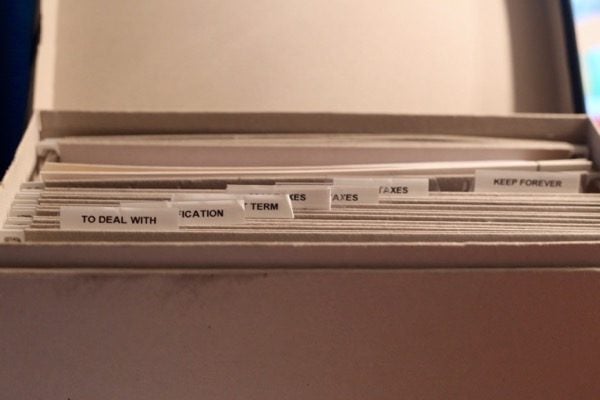
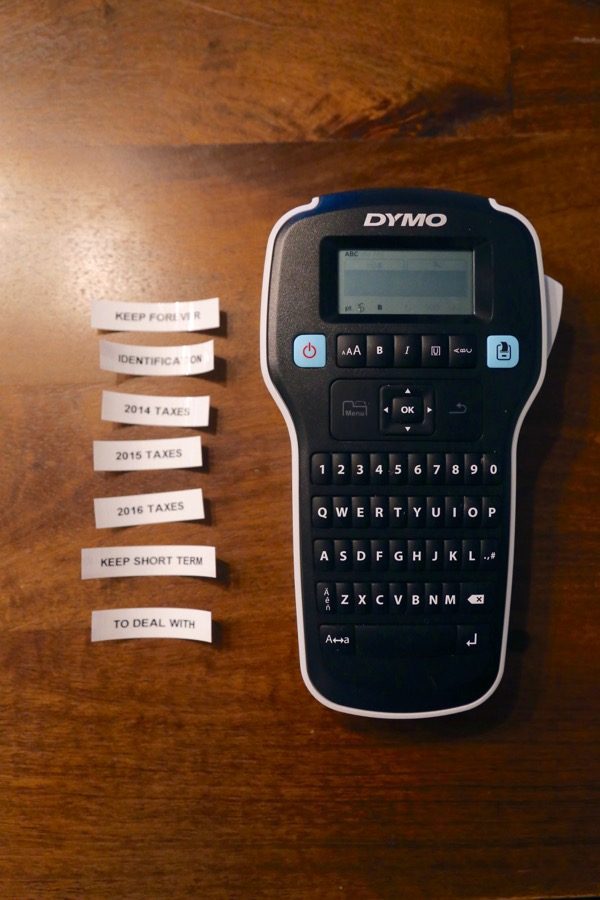
Step Five: Make an Upkeep Plan
This is the part where we’ve always struggled. We do this purging of paperwork every few years, but so far we’ve never kept up with maintaining it. Here are a few ways I attempted to remedy that:
- I moved our filing box to a more central location. Now that I have a desk area, I am keeping both our main filing box and my blog filing box right next to my desk – they’re out of the way but still very easy to access. We used to keep our paperwork upstairs in the guest room and it was always such a pain to access it when we needed it. I think this simple shift will go a long way to helping us maintain it.
- I got rid of any other paper storage systems. It sounds counterintuitive, but we used to have a little paper sorting system that attached to our fridge where we could drop papers off until we dealt with them later. But guess what happened? We never dealt with them. They would just stay in that little file for forever because they weren’t in our way. Now, we have absolutely nothing to organize and store our paperwork other than our simple filing system, which means all incoming paper will have to be dealt with quickly or else it will just be floating around the house driving me crazy!
- We set up weekly “business meetings.” I have a recurring alarm that will go off on my phone every Sunday afternoon during Jackson’s naptime – this will be when Corey and I sit down and review our budget, look at our finances, and deal with any paperwork that we need to address. Having a weekly date like this helps us to not put it off and say “we’ll do it tomorrow” and that little alarm going off every week is a really easy way to keep us on track. Now, all we have to do is grab the “to deal with” file out of the box, address anything that needs to be addressed, and go about our day!
It felt so good to organize paper clutter in our house. Paper clutter is something that makes me absolutely crazy, so I’m thrilled to hopefully have it taken care of once and for all.
Want more tips and tricks for organizing your home?
Here are the rest of the posts in our KonMari Organization series!


How do I know what papers to keep short term, and what to keep long term? So far I keep everything which has caused the problem.
Ok, Taxes-7 years, but want about things like past years insurance information? Receipts for things done in the houses we live in? Paid off loans? Help…being eaten by the paper monster
I wouldn’t keep anything that has expired (current year insurance info only). I only keep receipts/warranty info for things that can’t be found online, and I wouldn’t keep anything from paid off loans! Most of the information from all of those things can be found online these days, and if you really feel compelled to keep them you can always scan them and save them to your computer so they aren’ taking up space in your home!
Hello Amanda,
Great, advise! I need help with organizing bills. How long after paying a bill should I keep the receipts and bill statements? This is the majority of my clutter. Also, junk mail. How do manage junk mail from being a clutter problem?
Frazzled,
Elizabeth
Personally, I don’t keep it at all. It’s generally tracked online, so I see no reason to keep the paper version! Junk mail goes directly in the recycling bin before I even walk in the door from the mailbox!
Consider putting junk mail in a shred bin instead of a recycle bin. Credit cards offers are junk but should be shredded so that information is not stolen. It costs millions to recover your stolen identity.
Hi, your plan is helpful. Just a comment that the IRS asks us to keep tax records for seven years. I personally had the IRS notice an error from three years previously, and my records helped sort it out (I got some money back!). I don’t think two years is enough. Thanks for the other tips!
Hi Rebecca – good note! The official recommendation is to keep them for 3 years, but up to 7 years if there are potential errors or issues. But, it’s good to know you got extra money, and that’s definitely a good reason to consider keeping more!
HI. I am just starting mY decluttering journey. I was wandering do you keep a separate file/box for manuals for appliances/devices? And also once bills are paid do you hold onto any bills ? Thank you Theresa
Hi Theresa! I do not – I typically don’t keep manuals around, because most related information can be found online these days. Many manufacturers have their manuals on their website for download! However, if there were one I wanted to keep, I would just add it to my “keep long term” folder. As for bills, no I do not. We do the vast majority of our bill paying online, and it’s easy to find bills and statements on any companies’ website, so there’s no need to keep them around.
OOPS, sorry…wrong topic! You were discussing paperwork…and I mentioned clothes! I haven’t gotten to all the paperwork I have collected in the 3 month travels! (Going back to the U.S. in a few days!)
Hi
Loved your article and want to be part of the 30 day challenge and receive your ebook. I’m unable to subscribe though. Email is [email protected]
Hi! I just checked and you’re on the list! You should have received an email. 🙂
Hi, great video. I’m still unclear how to handle papers for work. I’m an author and have stacks of articles for research but I never am able to organize them. HELP !
Hi Cynthia – I recommend purging as much of it as you’re able to. Once you’ve gotten rid of as much as you can, my favorite method for storing research/articles is in a binder! Just grab a thick one and you can organize the papers you need in the binder. Once you’re done with a particular set of research, I’d toss that to make room for more. 🙂
Do you find that kids’ artwork builds up as well, especially when they’re little? I’ve been keeping the best bits in boxes as I’m hoping they’ll like looking through it when they’re older 😉
Absolutely! Here’s how we manage the day-to-day artwork avalanche in our house! 🙂
hi amanda,
i have looked at 20+ articles and all are pretty much the same. Action/File/Toss. But I need help with miscellaneous papers–reference/pending–I have several papers that are pending and reference or I just don’t know how to categorize them–bank/taxes/medical/kids school stuff-those are straightforward and basic, but can’t find anything about pending or reference. Do you have any suggestions for how to organize those types of papers?
Thanks and very nice website!
Cyndi
Hi Cyndi –
Any pending papers went into the “keep: short-term” folder for me. We also keep a separate “taxes” file in addition to the categories Kondo recommends.
I am currently on the ‘Paper’ stage of Marie Kondo’s The Magic of Tidying Up and came across your blog. I was also searching for a vertical file and ideas on desktop organization from others who also had read this book.
Just as sparingly as the author relegated paper sorting, she only devoted a few pages to them in her book.
Your photo of your finished central paper container puzzled me, however. It was not vertical, and the section ‘things to deal with,’ was quite small. Since it has been awhile now since your posting, I wanted to ask how is the final paper -working area working? 🙂
Hi Marianne – I don’t know how well the photos actually convey the system I used here, but we’ve actually shifted just a bit since this post was written. We now organize our paper in a one-drawer file cabinet system and just use the drop-in folders for each category Kondo recommends. We also have a small metal box in our kitchen to drop important papers that come in the mail, etc. It works well for us, as long as we stay on top of it!
OK, your paper pile is SO MUCH SMALLER than mine!! Ha ha! I am going to need like a 4-day, holiday weekend to deal with all of my paper at once.
Thanks, though, for these helpful tips! I am going to find a weekend that I can tackle this monumental project. I was able to do the clothing and books pretty quickly; finished them within a few hours. Paper, though. Ugh! I am a complete hostage to paper.
Hahaha I’ve always been big on throwing away papers as much as possible! 🙂 Good luck!!
Hello Amanda,
I hope that you are having a wonderful summer, Amanda as I send my request to you for the download package you created about the ways of the Konmari Method keeping our homes instead of them holding us hostage, lol. Would you be very kind to send it to me as I am not sure where some of my files went when I had to get a new laptop. Seems like socks to me, every once in a while one wanders off never to be found again, bwahahaha. I honestly do not mind the loss because I still have my photos of our life and that is what it really is all about, I reminded myself, firmly. Thank you kindly for doing this for those of us who had received them before.
Hi Lindy! I just emailed you the link to re-download it! 🙂
I am so with you on getting rid of all that paperwork. It just adds up so fast! The last time we did it we had papers covering not just our kitchen table but also the entire living room floor, lol. I am all about only keeping the bare minimum!
Yeah, the first time we did it we had a ton too. Paper clutter is the absolute worst!